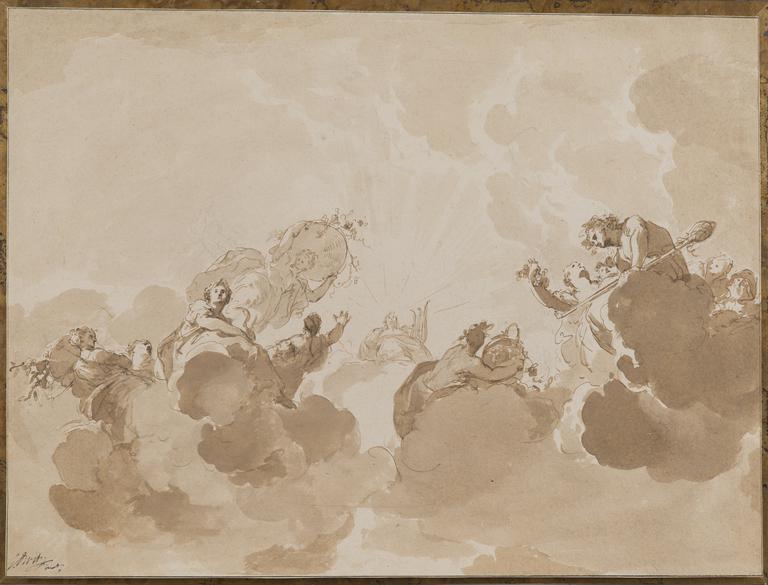
Apollon et les quatre saisons (?)
Jacob de Wit (1695 Amsterdam - 1754 Amsterdam)
1750 (vers)
Plume et encre brune sur traits de crayon noir, lavis brun, traits d’encadrement à l’encre noire ; signé « JDWit invt » en bas à gauche ; 34,6 x 46,6 cm
Provenance :
La Haye, de Wisser, 24-26 septembre 1872 (« Composition pour un plafond. A la plume, lavis de bistre, pièce capitale, signé ») ; Amsterdam, collection Johan Quirin van Regteren Altena ; Amsterdam, Christie’s, 10 décembre 2014.
Bibliographie :
Walter Liedtke, Dutch Paintings in the Metropolitan Museum of Art, vol II., New York, Metropolitan Museum of Art, 2007 ; Goltzius to van Gogh, Paris, Fondation Custodia, 2015, n° 99.
Après l’avènement de Guillaume III d’Orange au trône d’Angleterre en 1689, sa mort en 1702 sans qu’il soit remplacé dans la fonction de Stadhouder, et le traité d’Utrecht en 1713 qui met un terme à la guerre de Succession d’Espagne (où les Provinces-Unies n’avaient joué qu’un rôle marginal), Amsterdam entre dans une période de faste et de déclin. L’énergie du Siècle d’Or n’est plus, mais le capital accumulé fait d’Amsterdam la première place financière d’Europe. Les patriciens construisent et décorent des hôtels particuliers en ville et des manoirs à la campagne, comme au 16ème siècle, les patriciens vénitiens des palais le long du Grand Canal et des villas sur la Terre Ferme.
Un peintre vénitien justement, Pellegrini, qui séjourne aux Pays-Bas de fin 1716 à fin 1718, y apporte la légèreté de touche, le raffinement de couleur, le sens architectonique lointainement hérité de Véronèse. Jacob de Wit s’en inspire et jusqu’à sa mort en 1754, sera le peintre hollandais le plus demandé, le plus fortuné. Mais au contraire de Giambattista Tiepolo, son exact contemporain, il ne dirige pas un atelier ni ne voyage. Accaparé par les commandes des décors muraux ou plafonnants, sa réputation ne franchit pas les frontières, sinon par ses dessins, que généralement il prend la peine de signer.
Ce dessin, par son ampleur, son aération, sa fluidité, atteint un point de perfection dans l’œuvre et se situe probablement dans les dernières années de sa carrière, vers 1750. Il figurait dans la collection personnelle de Johan Quirin van Regteren Altena, un des grands historiens d’art néerlandais du siècle dernier, directeur du cabinet des dessins du Rijksmuseum de 1948 à 1962. Un dessin très proche, notamment dans sa partie gauche, appartient à la Fondation P. & N. de Boer, à Amsterdam.
Censé représenter Apollon (reconnaissable à sa lyre) et les quatre saisons, on peut se demander, eu égard à la difficulté d’identifier chacune des quatre saisons dans les figures différemment groupées d’un dessin à l’autre, si le sujet ne serait pas plutôt, ou aussi, le soleil (Apollon) et les fruits de la terre. Comme souvent dans les décors plafonnants, Jacob de Wit place la figure principale au centre, mais à l’arrière-plan, de la composition, un dispositif typiquement baroque qui crée la profondeur et retient l’intérêt du spectateur.
